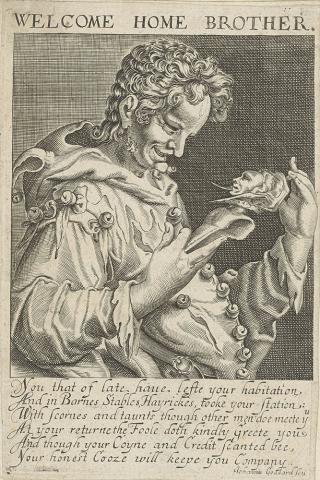
John Goddard, active 1645–1671
Welcome home brother
London, ca. 1665
Engraving; 178 x 118 mm
Bequest of Gordon N. Ray, 1987. PML 145850.98
Without knowing its underlying historical context, a viewer is likely to find this print from the Morgan’s collection bafflingly obscure. Once you learn it was published in London during the dark days of the Great Plague of 1665–1666, however, the meaning and significance of “Welcome Home Brother” begins to come into focus and strike an uncomfortably contemporary note.
The Great Plague threw the city into turmoil and killed an estimated fifteen to twenty percent of its inhabitants. Many residents, naturally enough from our perspective, chose to flee the congested city, but some Londoners who remained behind held the “runaways,” as they were termed by commentators of the day, in contempt. In this print, created circa 1665 by London engraver John Goddard (active 1645–1671), this sentiment is expressed through the artist’s pointed utilization of a preexisting design. It reproduces a print originally issued in the Netherlands in the late sixteenth century by Dutch artist and engraver Jacques de Gheyn (1565–1629). Gheyn’s engraving of a jester leering fondly at his bauble or “marotte” (i.e. a stick topped with a fool’s head to serve as a prop and foil for the bearer) was accompanied by text bearing a general proverbial observation on human folly summarized as “Each fool loves his own bauble.”
Goddard’s version of the engraving does not lend itself so readily to twenty-first-century interpretation. But when we consider the place and timing of its publication, the meaning of the print’s salutary address becomes evident, as it certainly would have been to his contemporaries. In the midst of the epidemic, the printmaker repurposed the iconography of Gheyn’s design to make a statement on the ongoing crisis. The accompanying verses:
You that of late have lefte your habitation,
And in Barnes Stables, Hayrickes, tooke your station:
With scornes and taunts though other men doe meete yu
At your returne the Foole doth kindly greete you,
And though your Coyne and Credit scanted bee,
Your honest Cooze will keepe you Company.
are specifically addressed to those runaway Londoners who sought to escape the epidemic by fleeing the stricken city to seek refuge in the surrounding countryside, leaving behind those who were either too poor to follow suit or forced to remain by professional or other obligations. For many of those left behind, the departure of their fellow Londoners was both a moral and material abandonment contributing to the manifold agonies of life in a city under siege by the plague, where the dead lay in heaps on the street, trade had been brought to standstill, and food and essential resources grew desperately scarce.
For those who fled, however, the widespread suffering could prove difficult to escape. While the wealthy or otherwise fortunate departed for country homes and relatively comfortable accommodations, many of London’s runaways found conditions outside the city far from hospitable. Residents of the countryside, terrified of the contagion, met their fellow countrymen with openly expressed fear and hostility and either drove them from their doors or seized the opportunity to fleece them by demanding extravagant sums for provisions. To compound their misfortunes, those who endured the hardships and deprivations of “living rough” in the country often returned penniless only to find their homes looted and businesses or careers in ruins.
Meanwhile, those who had survived the full horrors of the plague in their absence regarded their plight with the keen mix of resentment laced with schadenfreude so evident in Goddard’s engraving. The print, which hails the runaway as a “fool’s fool,” survives as a bitter jest at their expense and a testimony to the social divisions and internal conflicts that so often come to the fore in communities racked by plague, chaos, and collective fear.
The Morgan is fortunate to possess an extensive collection of popular prints, cartoons, and caricatures dating from the fifteenth to the twentieth centuries. Often ephemeral or topical in nature, surviving examples can pose a rewarding challenge to anyone interested in discovering the significance of an image within its original social and historical context. “Welcome Home Brother” forms part of an album believed to have been assembled by English bibliographer and antiquary Joseph Ames (1689–1759). The collection of prints, ephemera, and specimens of early printing dating from the fifteenth to the mid-eighteenth centuries were assembled into a volume entitled “Emblematical and satirical prints on persons and professions," which eventually found its way to the Morgan via collector Gordon N. Ray. Thanks to these collectors and others like them, we are able to examine obscure and arcane artifacts that, once understood, are not only comprehensible but in some cases have startling relevance to current events.
Sandra Carpenter
Gordon Ray Cataloger
The Morgan Library & Museum
